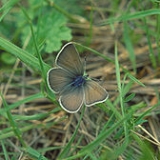
Fender's blue butterfly
Encyclopedia
Fender's blue is an endangered subspecies
of butterfly found only in the Willamette Valley
of northwestern Oregon
, United States
. The species was first noticed in the 1920s but wasn't scientifically documented and named until 1931 by biologist Ralph Macy. He named it for his friend, Kenneth Fender, an entomologist
and mail carrier, who died in 1987, just two years before the species was rediscovered. http://www.ia.ucsb.edu/pa/display.aspx?PKey=450 Later in the 1930s the species was presumed to be extinct, but small populations were rediscovered in 1989. In January 2000, the Fender's blue was added to the Endangered Species List by the U.S. Fish and Wildlife Service. Currently, the largest known populations of this butterfly exist in the Baskett Slough National Wildlife Refuge
.
Fender's blue butterflies are completely dependent upon the successful continuation of a threatened
plant species, known as Kincaid's lupine
. The butterflies deposit their eggs on the plants in May which hatch in June each year. The larva
e then winter in the root system of the plants. In March they emerge as caterpillar
s, crawl up the plants, and feed on the lupin
e leaves. After several molting periods, Fender's blue butterflies finally metamorphose, changing into butterflies, and in the short week to ten days remaining in their lives, they mate and then deposit new eggs for the next generation, continuing the life cycle. With most of the habitat where the lupine existed now lost to agriculture and urbanization, only isolated and protected lands support enough area for the plant to survive. It produces around once every 52 weeks, and have about six offsprings that survive to become adults.
Endangered species
An endangered species is a population of organisms which is at risk of becoming extinct because it is either few in numbers, or threatened by changing environmental or predation parameters...
of butterfly found only in the Willamette Valley
Willamette Valley
The Willamette Valley is the most populated region in the state of Oregon of the United States. Located in the state's northwest, the region is surrounded by tall mountain ranges to the east, west and south and the valley's floor is broad, flat and fertile because of Ice Age conditions...
of northwestern Oregon
Oregon
Oregon is a state in the Pacific Northwest region of the United States. It is located on the Pacific coast, with Washington to the north, California to the south, Nevada on the southeast and Idaho to the east. The Columbia and Snake rivers delineate much of Oregon's northern and eastern...
, United States
United States
The United States of America is a federal constitutional republic comprising fifty states and a federal district...
. The species was first noticed in the 1920s but wasn't scientifically documented and named until 1931 by biologist Ralph Macy. He named it for his friend, Kenneth Fender, an entomologist
Entomology
Entomology is the scientific study of insects, a branch of arthropodology...
and mail carrier, who died in 1987, just two years before the species was rediscovered. http://www.ia.ucsb.edu/pa/display.aspx?PKey=450 Later in the 1930s the species was presumed to be extinct, but small populations were rediscovered in 1989. In January 2000, the Fender's blue was added to the Endangered Species List by the U.S. Fish and Wildlife Service. Currently, the largest known populations of this butterfly exist in the Baskett Slough National Wildlife Refuge
Baskett Slough National Wildlife Refuge
Baskett Slough National Wildlife Refuge is located in northwestern Oregon, 10 miles west of Salem in Polk County. Situated in open farmland near the eastern foothills of the Oregon Coast Range with the broad Willamette Valley and the Cascade Range to the east, elevations range from 185 to...
.
Fender's blue butterflies are completely dependent upon the successful continuation of a threatened
Threatened species
Threatened species are any speciesg animals, plants, fungi, etc.) which are vulnerable to endangerment in the near future.The World Conservation Union is the foremost authority on threatened species, and treats threatened species not as a single category, but as a group of three categories,...
plant species, known as Kincaid's lupine
Lupinus sulphureus
Lupinus sulphureus is a species of lupine native to western North America from southern British Columbia south through Washington to Oregon. It is a perennial herbaceous plant growing to 40-80 cm tall. The leaves are palmately compound, with 7-13 leaflets, the leaflets 2-5 cm long...
. The butterflies deposit their eggs on the plants in May which hatch in June each year. The larva
Larva
A larva is a distinct juvenile form many animals undergo before metamorphosis into adults. Animals with indirect development such as insects, amphibians, or cnidarians typically have a larval phase of their life cycle...
e then winter in the root system of the plants. In March they emerge as caterpillar
Caterpillar
Caterpillars are the larval form of members of the order Lepidoptera . They are mostly herbivorous in food habit, although some species are insectivorous. Caterpillars are voracious feeders and many of them are considered to be pests in agriculture...
s, crawl up the plants, and feed on the lupin
Lupin
Lupinus, commonly known as Lupins or lupines , is a genus in the legume family . The genus comprises about 280 species , with major centers of diversity in South and western North America , and the Andes and secondary centers in the Mediterranean region and Africa Lupinus, commonly known as Lupins...
e leaves. After several molting periods, Fender's blue butterflies finally metamorphose, changing into butterflies, and in the short week to ten days remaining in their lives, they mate and then deposit new eggs for the next generation, continuing the life cycle. With most of the habitat where the lupine existed now lost to agriculture and urbanization, only isolated and protected lands support enough area for the plant to survive. It produces around once every 52 weeks, and have about six offsprings that survive to become adults.

